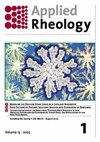Rheological and Mechanical Gradient Properties of Polyurethane Elastomers for 3D-Printing with Reactive Additives
IF 1.8
4区 工程技术
Q1 MECHANICS
引用次数: 3
Abstract
Abstract Polyurethane (PU) elastomers with their broad range of strength and elasticity are ideal materials for additive manufacturing of shapes with gradients of mechanical properties. By adjusting the mixing ratio of different polyurethane reactants during 3D-printing it is possible to change the mechanical properties. However, to guarantee intra- and inter-layer adhesion, it is essential to know the reaction kinetics of the polyurethane reaction, and to be able to influence the reaction speed in a wide range. In this study, the effect of adding three different catalysts and two inhibitors to the reaction of polyurethane elastomers were studied by comparing the time of crossover points between storage and loss modulus G′ and G′′ from time sweep tests of small amplitude oscillatory shear at 30°C. The time of crossover points is reduced with the increasing amount of catalysts, but only the reaction time with one inhibitor is significantly delayed. The reaction time of 90% NCO group conversion calculated from the FTIR-spectrum also demonstrates the kinetics of samples with different catalysts. In addition, the relation between the conversion as determined from FTIR spectroscopy and the mechanical properties of the materials was established. Based on these results, it is possible to select optimized catalysts and inhibitors for polyurethane 3D-printing of materials with gradients of mechanical properties.活性添加剂用于3D打印的聚氨酯弹性体的流变和力学梯度性能
摘要聚氨酯(PU)弹性体具有广泛的强度和弹性,是增材制造机械性能梯度形状的理想材料。在3D打印过程中,通过调整不同聚氨酯反应物的混合比例,可以改变机械性能。然而,为了保证层内和层间粘合,必须了解聚氨酯反应的反应动力学,并能够在大范围内影响反应速度。在本研究中,通过比较30°C下小振幅振荡剪切的时间扫描测试中储存和损失模量G′和G′′之间的交叉点时间,研究了添加三种不同催化剂和两种抑制剂对聚氨酯弹性体反应的影响。交叉点的时间随着催化剂用量的增加而减少,但只有一种抑制剂的反应时间显著延迟。根据FTIR光谱计算的90%NCO基团转化率的反应时间也证明了具有不同催化剂的样品的动力学。此外,还建立了FTIR光谱测定的转化率与材料力学性能之间的关系。基于这些结果,可以为具有机械性能梯度的材料的聚氨酯3D打印选择优化的催化剂和抑制剂。
本文章由计算机程序翻译,如有差异,请以英文原文为准。
求助全文
约1分钟内获得全文
求助全文
来源期刊

Applied Rheology
物理-力学
CiteScore
3.00
自引率
5.60%
发文量
7
审稿时长
>12 weeks
期刊介绍:
Applied Rheology is a peer-reviewed, open access, electronic journal devoted to the publication in the field of applied rheology. The journal provides the readers with free, instant, and permanent access to all content worldwide; and the authors with extensive promotion of published articles, long-time preservation, language-correction services, no space constraints and immediate publication.
 求助内容:
求助内容: 应助结果提醒方式:
应助结果提醒方式:


